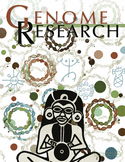Functional diversity for REST (NRSF) is defined by in vivo binding affinity hierarchies at the DNA sequence level
- Alexander W. Bruce1,5,10,
- Andrés J. López-Contreras2,4,
- Paul Flicek3,4,
- Thomas A. Down1,4,5,
- Pawandeep Dhami1,6,
- Shane C. Dillon1,7,
- Christoph M. Koch1,
- Cordelia F. Langford1,
- Ian Dunham1,8,
- Robert M. Andrews1 and
- David Vetrie1,9,10
- 1 The Wellcome Trust Sanger Institute, Wellcome Trust Genome Campus, Hinxton, Cambridgeshire CB10 1SA, United Kingdom;
- 2 Department of Biochemistry and Molecular Biology, Faculty of Medicine, University of Murcia, Campus de Espinardo, 30100 Murcia, Spain;
- 3 EMBL—European Bioinformatics Institute, Wellcome Trust Genome Campus, Hinxton, Cambridge CB10 1SD, United Kingdom
-
↵4 These authors contributed equally to this work.
Abstract
The molecular events that contribute to, and result from, the in vivo binding of transcription factors to their cognate DNA sequence motifs in mammalian genomes are poorly understood. We demonstrate that variations within the DNA sequence motifs that bind the transcriptional repressor REST (NRSF) encode in vivo DNA binding affinity hierarchies that contribute to regulatory function during lineage-specific and developmental programs in fundamental ways. First, canonical sequence motifs for REST facilitate strong REST binding and control functional classes of REST targets that are common to all cell types, whilst atypical motifs participate in weak interactions and control those targets, which are cell- or tissue-specific. Second, variations in REST binding relate directly to variations in expression and chromatin configurations of REST's target genes. Third, REST clearance from its binding sites is also associated with variations in the RE1 motif. Finally, and most surprisingly, weak REST binding sites reside in DNA sequences that show the highest levels of constraint through evolution, thus facilitating their roles in maintaining tissue-specific functions. These relationships have never been reported in mammalian systems for any transcription factor.
Footnotes
-
↵5 Present addresses: Wellcome Trust/Cancer Research UK Gurdon Institute, The Henry Wellcome Building of Cancer and Developmental Biology, University of Cambridge, Tennis Court Road, Cambridge CB2 1QN, UK;
-
↵6 University College London Cancer Institute, Paul O'Gorman Building, University College London, 72 Huntley Street, London WC1E 6BT, UK;
-
↵7 School of Genetics and Microbiology, Moyne Institute of Preventative Medicine, Trinity College, Dublin 2, Ireland;
-
↵8 EMBL—European Bioinformatics Institute, Wellcome Trust Genome Campus, Hinxton, Cambridge CB10 1SD, UK;
-
↵9 Section of Pathology and Gene Regulation, Division of Cancer Sciences and Molecular Pathology, University of Glasgow, Western Infirmary, Dumbarton Road, Glasgow G11 6NT, UK.
-
↵10 Corresponding authors.
E-mail dlv1q{at}clinmed.gla.ac.uk; fax 44-0141-337-2494.
E-mail awb41{at}cam.ac.uk; fax 44-01223-334089.
-
[Supplemental material is available online at www.genome.org. The REST ChIP-chip data from this study have been submitted to ArrayExpress (http://www.ebi.ac.uk/microarray-as/ae/) under accession no. E-TABM-660.]
-
Article published online before print. Article and publication date are at http://www.genome.org/cgi/doi/10.1101/gr.089086.108.
-
- Received November 10, 2008.
- Accepted February 23, 2009.
-
Freely available online through the Genome Research Open Access option.
- Copyright © 2009 by Cold Spring Harbor Laboratory Press











